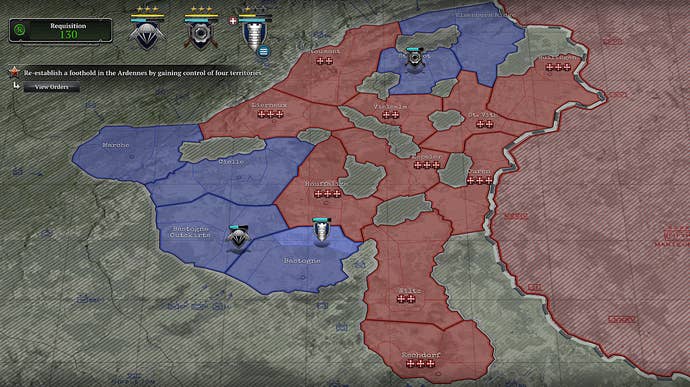Company of Heroes 2: Ardennes Assault PC Review: Total War
Relic expands Company of Heroes' scope with their latest standalone expansion.
This article first appeared on USgamer, a partner publication of VG247. Some content, such as this article, has been migrated to VG247 for posterity after USgamer's closure - but it has not been edited or further vetted by the VG247 team.
I've never experienced combat firsthand, but Company of Heroes 2: Ardennes Assault is what I imagine war must be like: An intense, harrowing slog through broken buildings and shatteringly loud artillery fire with little to no margin for error.
Such experiences have been Company of Heroes' bread and butter since the series' debut in 2006, and it is reflected well in Ardennes Assault—the latest expansion to grace Company of Heroes 2. This time around, however, Relic has seen fit to widen the scope of the battle in a way that has rarely been seen in real-time strategy to this point; and happily, it works. Frustrating at is can be at times, Ardennes Assault does a great job of capturing both the scale and the desperation of the Battle of the Bulge—the last ditch German counterattack that nearly broke the Allied advance in 1945.
The second standalone expansion for Company of Heroes 2 following the multiplayer-focused Western Front Armies, Ardennes Assault is set over the six week period following Germany's surprise counteroffensive, which serves to set the campaign in motion. Its main conceit is a strategic map in which three companies—mechanized, support, and airborne—are moved around like pieces in a chess game, with the goal being to retake territory held by the Germans. As the campaign progresses, more and more ground shifts toward the Allies, but German forces also become increasingly concentrated as they are pushed to a few corners of the map.
Such concentrations pose major problems in the latest stages of the campaign, as they give the CPU innumerable advantages—better equipment, veteran troops, and snipers among them. What's more, the Allied companies are apt to be exhausted from fighting at that point—reflected in the steady deterioration of what amounts to a stamina bar—leaving very little room for error. As in real life, the best way to avoid such a situation is to block a fleeing enemy from escaping following a defeat by properly arraying your companies on the map, which is occasionally easier said than done.
Such moments are a reflection of the realities of the war, which plays nicely into Company of Heroes' commitment to realism. They make the campaign feel like a cohesive whole—almost like a board game—rather than an isolated story that is told mission-by-mission. One consequence of this approach is that the story is told more as a heroic overarching narrative than a series of individual stories, despite the missions being bracketed by largely superfluous diary entries from company commanders. If a strong, cohesive story is your thing, then Ardennes Assault may disappoint you. But in a way, the strategy tells its own story as the campaign progresses, which for me is more compelling than any fixed narrative since I play a key role in how it unfolds.

That said, the strategy is driven in large part by what is bound to be the most controversial element of Ardennes Assault—the inability to save and reload after a failed mission. It's still possible to save and quit, but if you screw up, you will by and large have to face the consequences. Mostly, that means retrying a failed mission with a lower stamina gauge; but fail too much, and you can actually suffer a game over and be forced to start from the beginning. Granted, it does serve to substantially raise the stakes of individual encounters, but it also magnifies the effects of mistakes and occasionally becomes almost overwhelming. I love that it's there, but I also sort of wish that it were optional.
On the ground, the missions fit a handful of archetypal objectives—capture and hold being a big one. Such missions tend to be the most stressful, as they require a coordinated buildup, good scouting, and a flexible plan of attack that doesn't stretch limited forces too thin. In many ways, they follow the format of the multiplayer matches, down to the presence of victory points that decline depending on which side holds the most capture points. The majority of my most memorable battles took place on capture and hold maps, with the biggest being a back-and-forth fight in which I slowly pushed from east to west amid heavy resistance in a bid to grab three capture points, after which I was forced to hold on for dear life amid a fierce counterattack.
In keeping with the boardgame dynamic, random events take place on the strategic map, and there are optional secondary objectives to be completed over the course of individual missions. Successful missions earn you requisition points, which can then be spent on company upgrades or reinforcement, the latter which rebuild the stamina gauge at the expense of experience points. The campaign climaxes in a grand final battle—an appropriate finale for one of World War II's most important battles.

I ultimately came away from Ardennes Assault feeling as if I had just completed a long and difficult military campaign—a ten-hour battle of attrition that forced me to stay on my toes and use my head throughout. It was both enjoyable and exhausting; and while I found the strategy addicting in its own way, I'm not sure I would recommend it to those who are new to the series, despite being a standalone expansion. The lack of a save and reload mechanic is bold, but it also makes certain missions almost overwhelming, which is bound to be a problem for anyone who doesn't have a complete grasp on the mechanics. Give the fully Company of Heroes 2 campaign a try before diving into the expansion.
I should add that I don't necessarily hold Ardennes Assault's difficulty against it. Actually, I find it kind of exhilirating to in essence be playing without a net—it made me feel almost like a real commander on the field. In that, Relic's stab at grand strategy proves a worthwhile venture, and one I hope they revisit at some point in the future. Company of Heroes has always been good at providing snapshots of the war on the field; but in this case, Ardennes Assault makes me feel as if I'm finally seeing the whole picture.
VisualsCompany of Heroes 2's engine has held up pretty well over the years despite being rather similar to that of the original. Ardennes Assault has not seen any significant upgrades.
SoundCompany of Heroes 2's audio design is one of its biggest strengths, with the intensity of the gunfire and explosions doing much to enhance the combat. The repetitive complaints from the troops are a tad more annoying.
InterfaceThe new strategic map is clean and easy to understand, as is the unit upgrade screen. The actual flow of the combat takes a bit to grasp,
Lasting AppealThe campaign takes between 10-12 hours to complete. Dynamic missions and objectives add to its replayability; but as a single-player focused campaign, it's not apt to last much longer than that. Of course, there's always the multiplayer to keep you busy.
ConclusionArdennes Assault represents an intriguing twist on the established Company of Heroes 2 formula, introducing a strategic element that adds to the scope of the combat and offers a more complete picture of the Battle of the Bulge than has typically been possible in a real-time strategy game. In that, Relic's latest standalone expansion represents the best elements of real-time and turn-based strategy, making it worth playing for anyone who appreciates the form and likes to see it taken in new directions.









